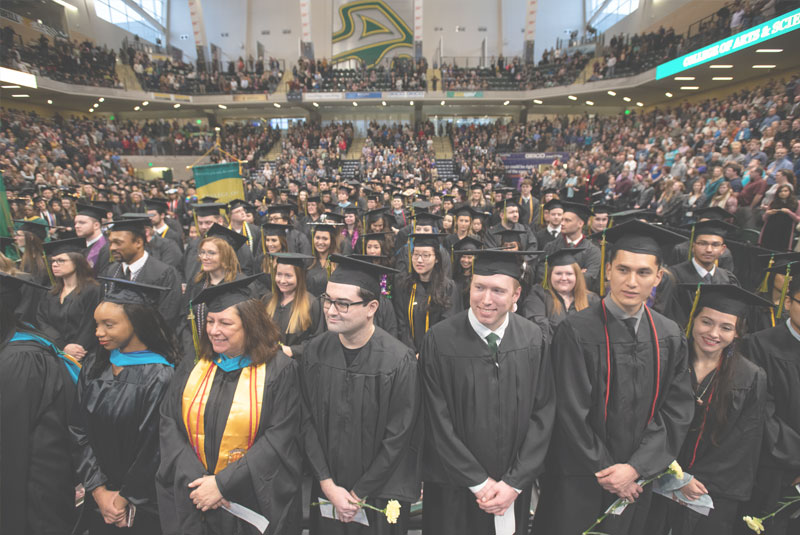Due to deteriorating and unsafe road conditions in Anchorage and the surrounding areas, the Anchorage campus will close at 3:30 p.m. today, Monday, Jan. 6, 2025. Athletics competitions and some other activities will continue as scheduled. Check email for additional info.
Students simulate prisoner reentry to grasp its hurdles
by Matt Jardin |

Participants stand in long lines as they attempt to complete the tasks required of their characters during a Reentry Simulation at Lucy Cuddy Hall. Organized by the Anchorage Reentry Coalition, the simulation is designed to teach students and community members about the struggles faced by people returning to society after incarceration. (Photo by James Evans / University of Alaska Anchorage)
To paraphrase the old axiom, don't judge a person until you walk a mile in their shoes.
Short of literally wearing someone else's shoes, UAA College of Health (COH) students did just that during the Reentry Simulation at Lucy Cuddy Hall the morning of Friday, Nov. 1. The exercise aimed to show participants the many hurdles a released prisoner has to go through upon reentering society.

Justice Center assistant professor Rita Augustyn checks in participants at the Reentry Simulation. (Photo by James Evans / University of Alaska Anchorage)
"Depending on their positions in the community, whether they're a student, law enforcement officer, case manager or policymaker, hopefully after the simulation they can take what they learned and do their job a little differently, view the situation a little differently or have different conversations," said Jonathan Pistontnik, who organized the event as the coalition coordinator for the Anchorage Reentry Coalition (ARC).
During the simulation, participants were assigned a character, complete with name, the crime for which they were incarcerated and other factors including any disabilities or dependents.
The event was divided into quarters with each segment representing one week. Each week, participants had to use their limited financial and transportation resources to juggle tasks like paying rent, going to doctor appointments and attending probation officer meetings. Usually, completing one task, like getting a job, would require the completion of another task completely unknown to the participant, like first having to go to the DMV and pay for a state ID.
[embed]https://www.youtube.com/watch?time_continue=40&v=gRZpBLBkGcY[/embed]
Just how accurate was the simulation? According to the event's keynote speaker, Genesis Recovery Services peer support specialist and former reentrant Rashad Arnsworth, the exercise seemed to provide a thorough re-creation.
"It's like starting your life all over at an adult age," said Arnsworth. "I'm seeing a lot of people getting frustrated, and this is how it really is when you get back. This way is not working. They say it's going to work but it's not. Forget all of this, I'm going to start doing crime again, and they come right back. This is how the cycle continues."
The simulation at UAA was the sixth in Anchorage, with others having been established in Fairbanks and Juneau, and one planned for Mat-Su on Nov. 20. While new in Alaska, these events are part of a broader initiative from the U.S. Department of Justice known as Project Safe Neighborhoods. The goal is to bring together federal, state, local and tribal law enforcement officials as well as community leaders to identify and address the most pressing violent crime issues in specific communities.

Participants exchange tickets for services as they try to complete the tasks required of their characters during the Reentry Simulation. (Photo by James Evans / University of Alaska Anchorage)
"When reentrants succeed, public safety is better, simply because those individuals who were previously out committing crimes are now employed, have housing and have their treatment needs met," said Yulonda Candelario, law enforcement, reentry and community outreach coordinator with the U.S. Attorney's Office. "Overall, the reduction in violent crime in areas that employ violence reduction strategies is anywhere between 4% and 20%."
Friday's exercise was also the first one done in partnership with the UAA Justice Center. Hopefully, many more collaborations will follow as the simulation is a perfect crash course for students in COH - which include legal studies, human services, social work and nursing majors - embarking on a career that is involved in the reentry process, whether they are aware of it or not.
"The idea of getting students from the entire College of Health is to show how much reentry permeates into many aspects of the community and that many organizations are involved, not just the criminal justice system," said Rita Augustyn, Ph.D., assistant professor at the Justice Center and author of a textbook chapter on how successful prisoner reentry can serve as crime prevention.

Human services major Ryan Holden attempts to navigate the system during the Reentry Simulation. (Photo by James Evans / University of Alaska Anchorage)
The effects of the inaugural partnership between UAA and ARC have already been felt. Just ask human services major Ryan Holden. During the event, Holden role-played as "Shawn," who was released with only $20 to his name after serving a three-year prison sentence for breaking and entering and burglary. Additionally, "Shawn" also had to navigate reentry while having a disability and no immediate means for treatment.
"It's eye-opening to see what people have to come up against coming out of the system," said Holden. "It definitely gives me a newfound sense of empathy."

Participants stand in long lines to check in with parole officers as they attempt to complete the tasks required of their characters during the Reentry Simulation. (Photo by James Evans / University of Alaska Anchorage)
Written by Matt Jardin, UAA Office of University Advancement
 "Students simulate prisoner reentry to grasp its hurdles" is licensed under a Creative Commons Attribution-NonCommercial 4.0 International License.
"Students simulate prisoner reentry to grasp its hurdles" is licensed under a Creative Commons Attribution-NonCommercial 4.0 International License.













